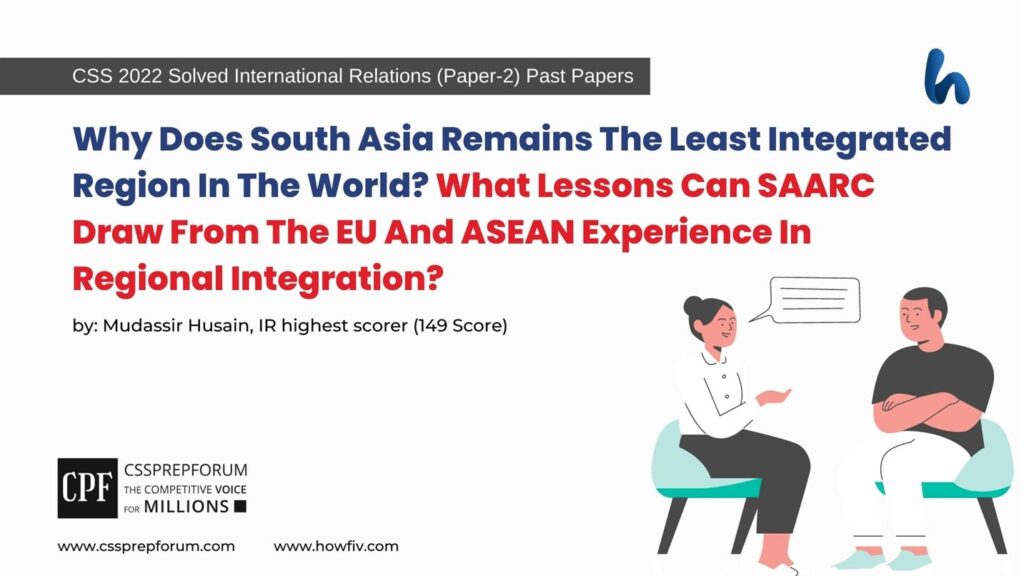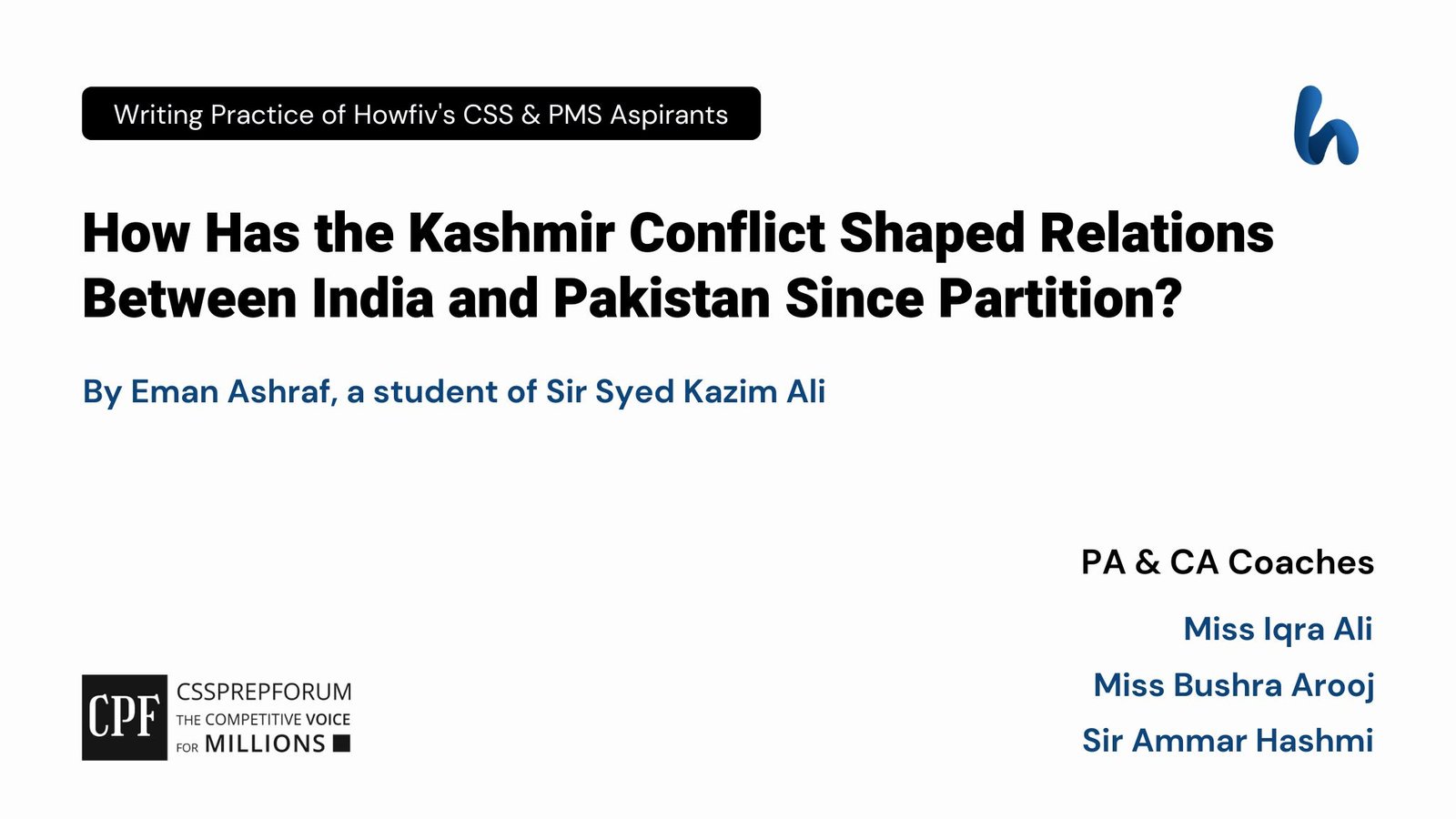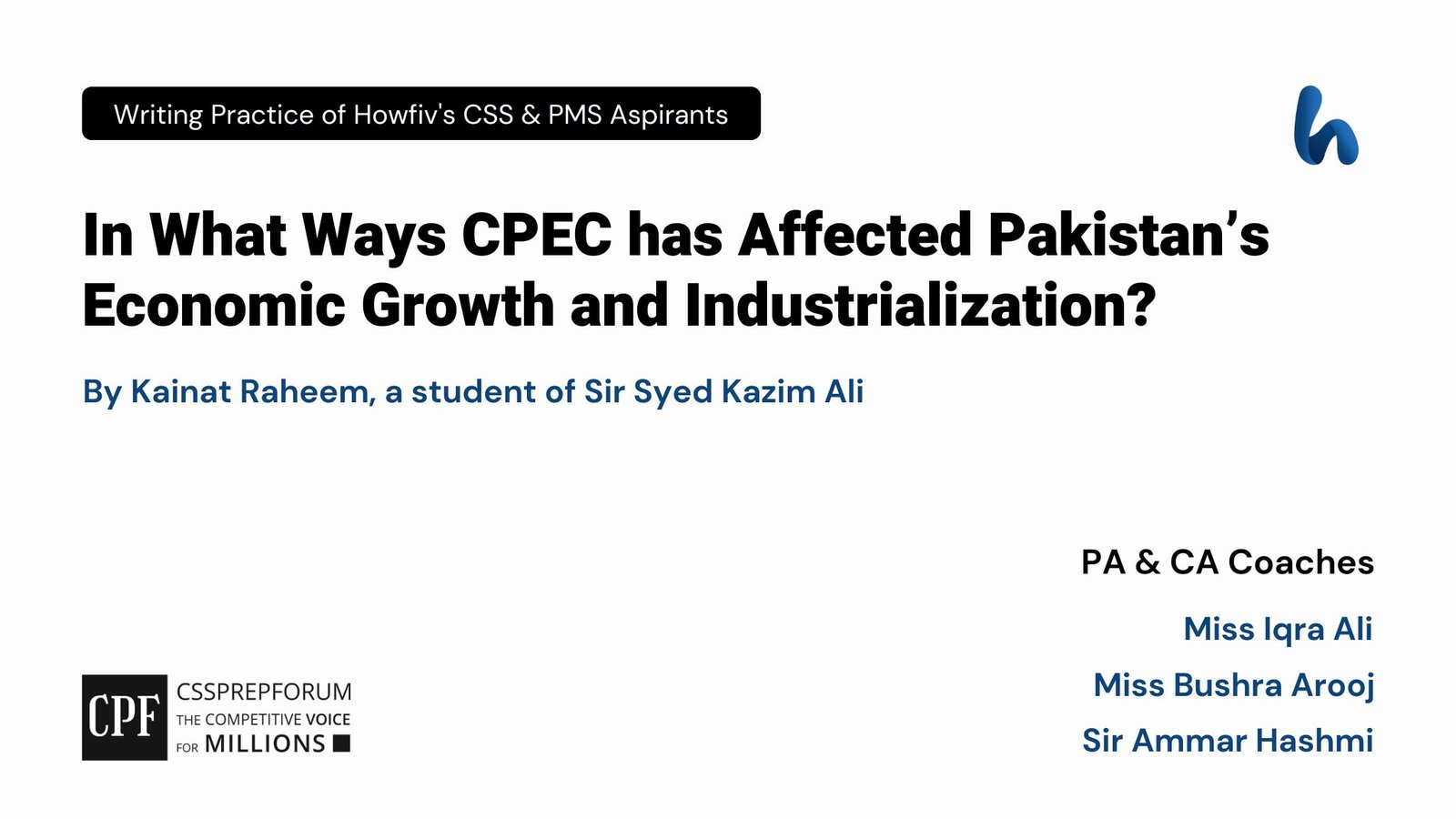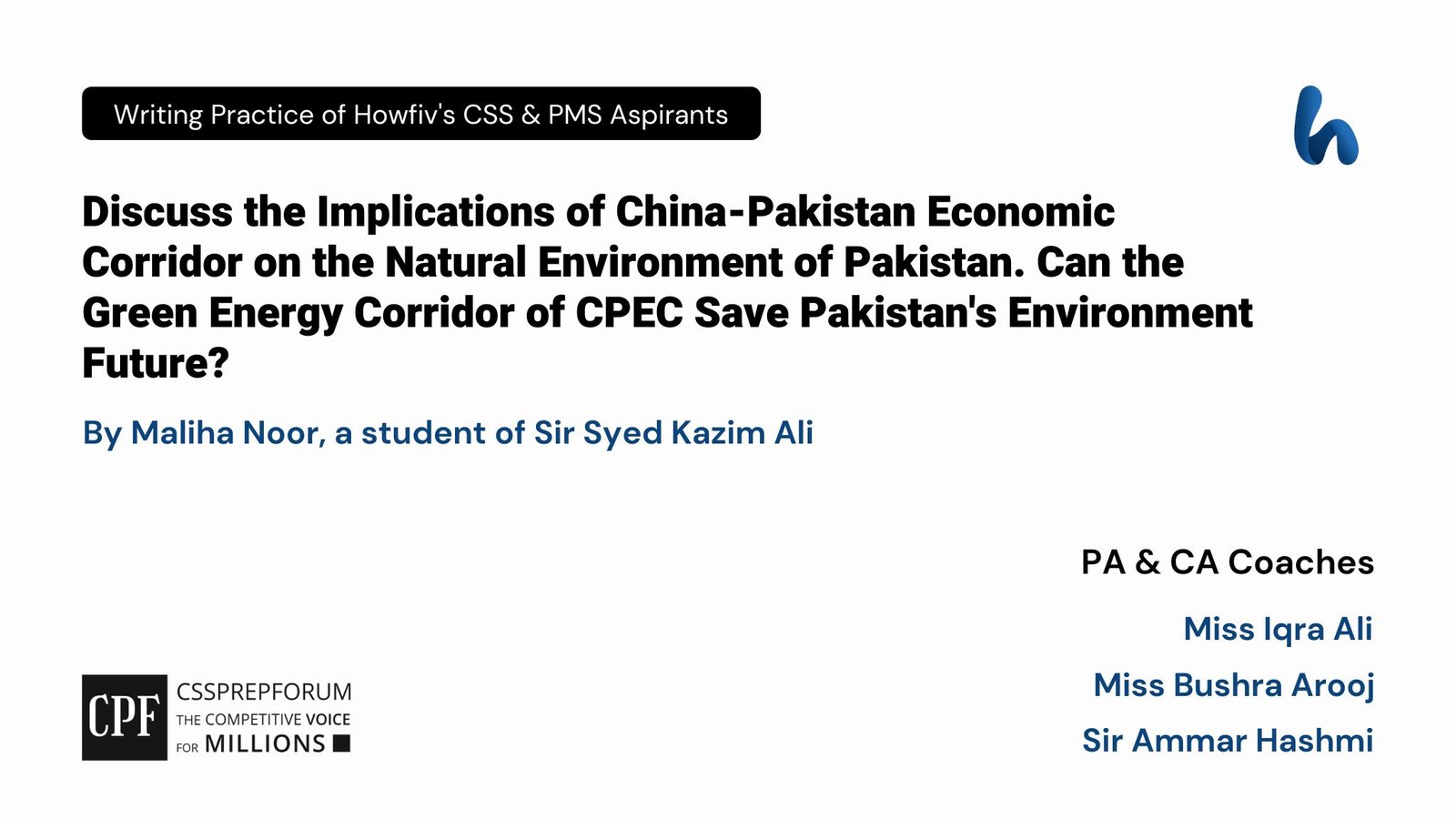CSS Solved International Relations Paper 2 Past Papers | Why Does South Asia Remains The Least Integrated Region In The World? What Lessons Can SAARC Draw From The EU And ASEAN Experience In Regional Integration?
Mudasir Hussain, the highest scorer in the CSS IR paper, attempts the following question. The question is attempted in the same way that Miss Abeera Fatima, the top IR scorer, has been attempting. Moreover, the answer is written on the same pattern, taught by Sir to his students, scoring the highest marks in compulsory subjects for years. This solved past paper question is uploaded to help aspirants understand how to crack a topic or question, how to write relevantly, what coherence is, and how to include and connect ideas, opinions, and suggestions to score the maximum.
QUESTION BREAKDOWN
In this question, the examiner wants to know if you are clear about the idea of integration and wants you to demonstrate that South Asia is one of the least integrated regions in the world. You can draw a map of South Asia after the second heading to get better marks. Additionally, you have to answer two questions: first, he wants you to tell him why South Asia is the least integrated region, with underlying IR theory behind every reason, and second, he asked about the political and economic integration in the EU and ASEAN through logical patterns and ideas by asking you what can South Asian region learn from its counterparts in Europe and Southeast Asia. Remember, you are supposed to tell what techniques might be used in the integration and how these techniques can implement since there is no ‘one size fits all’ model for regional integration rather than telling how integration in EU and ASEAN took place. Finally, every recommendation must support by an underlying IR theory.

Outline
INTRODUCTION
AN OVERVIEW OF THE MANIFESTATION OF THE SOUTH ASIA REMAINS THE LEAST INTEGRATED REGION IN THE WORLD
WHY DOES THE SOUTH ASIAN REGION REMAIN THE LEAST INTEGRATED?
- ✓ Bilateral issues between the two nuclear states
- ✓ No common enemy to bring together the rivals
- ✓ Global rivalries and alternatives such as CPEC, BRICS, and BIMSTEC
- ✓ Lack of strong regional institutions and mechanisms for cooperation and integration: Unanimous vote issue
A GLIMPSE OF THE LESSONS LEARNED BY SAARC FROM EU AND ASEAN
- ✓ Ensuring that integration is slow and upward
- ✓ Understanding the benefits of intraregional trade over interregional trade
- ✓ Utilizing alternate forums such as SCO followed by the EU in NATO
- ✓ Adopting flexibility in the integration process
- ✓ Reforming SAARC
CONCLUSION

INTRODUCTION
South Asian region has been haunted owing to its conflictual history and political tensions between states, particularly Pakistan and India, that created an atmosphere of mutual distrust and have prevented the flourishing process of integration in the region. The return of global power rivalries and the consequential emergence of bloc politics have added fuel to the fire of already heated tensions among various players. It has made South Asia one of the least integrated regions in the world. South Asia has not been the only region where such problems existed that does not have to reinvent the wheel; however, lessons can be taken into consideration from the EU and ASEAN as they made integration possible despite facing the same problems. The integration can be made possible by taking a gradual approach and waiting for the “spillover effect” to act accordingly and should be ideally preceded by economic interdependence. Only then the security dilemma and zero-sum game approach overcome that can lead to the integration.
AN OVERVIEW OF THE MANIFESTATION OF THE SOUTH ASIA REMAINS THE LEAST INTEGRATED REGION IN THE WORLD
The intraregional trade in South Asia stood at 5% of its total trade volume, which is very low compared to other regions, for instance, 68 percent in the EU and 25 percent in ASEAN, in terms of economy. The economic integration is even less than in Africa, where 10% of total trade is intraregional. Politically, SAARC- the only South Asian forum- has not held its annual meeting since 2015 since India and its allies in the region have boycotted the meeting to conduct in Pakistan. The situation is similar in the social domain since Pakistan and India have banned the movement of people, art, and artists, which has turned the Redcliff line into nothing short of the Berlin Wall.
FACTORS THAT MAKE SOUTH ASIA THE LEAST INTEGRATED REGION IN WORLD
CONFLICTUAL HISTORY AND POLITICAL TENSIONS BETWEEN PAKISTAN AND INDIA
Pakistan and India are political and geographical centerpieces of the region; however, the animosity between the two needs no introduction. The security dilemma of Pakistan, as realists would argue, emanates from Indian designs: Cold Start doctrines, Indian actions in Kashmir, and constant warmongering by Indian leaders to gain electoral success at home, which indicate the impact of domestic discourse on foreign policy as propounded by liberal theorist, has paralyzed any hope for cooperation between the two countries and hence the region.
NO COMMON ENEMY TO BRING TOGETHER THE COUNTRIES
Realists have long argued that international orders and institutions have been the product of exclusivity, not inclusivity, a dynamic that IR scholars termed as “orders of exclusion.” European Union, an outcome of the European Coal Community, is to keep Germany in check; on the other hand, North Atlantic Treaty Organization (NATO) is to hinder the westward march of the Soviet Union. The Association of Southeast Asian Nations (ASEAN) formed in the 1960s became functional and operative in its true spirit when it faced giants like China, India, and the EU in the late 90s and early 2000s. South Asian states have so far failed to pinpoint a common enemy and hence do not see a necessity to be a united front.
GLOBAL RIVALRIES, BLOC POLITICS, AND PRESENCE OF ALTERNATIVES TO REGIONAL INTEGRATION
Conforming to the neo-realist assumptions that the international structures define the behavior of actors, the emergence of global rivalries, particularly between the US and China, has eroded any semblance of unity in the region. The US has been fostering India as a bulwark against China, an all-weather friend of Pakistan. It has increased tensions between Pakistan and India and provided them with alternatives to regional cooperation. Pakistan seems to have put all eggs in the CPEC basket; India believes that extra-regional arrangements such as (Brazil, Russia, India, China, and South Africa) BRICS and (the Bay of Bengal Initiative for Multi-Sectoral Technical and Economic Cooperation) BIMSTEC better serve its interests. It validates the realist perspective that states worry more about security and survival than economic benefits.
LACK OF STRONG REGIONAL INSTITUTIONS AND MECHANISMS FOR COOPERATION AND INTEGRATION
The only institution developed for cooperation in the region has been cooperation SAARC, which is not strong enough to carry out its objectives for two reasons. Firstly, its voting method of having a unanimous vote mentioned in Article X of the SAARC Charter to agree on something is no less bound to failure than the League of Nations, which also had the condition of unanimity. Second, the member states cannot discuss bilateral issues. The institutional theory suggests that institutions work by providing a platform to discuss and decrease the cost of negotiations and prevention of bilateral conflicts devoid of SAARC of that very advantage.
LESSONS THAT SAARC CAN LEARN FROM EU AND ASEAN
PURSUING A GRADUAL APPROACH AND STARTING WITH LITTLE
The EU and ASEAN were not built in a day, and their integration was slow and gradual. For instance, the economic integration of the EU can be traced back to an agreement immediately after WWII, which provided for rules of coal trade between Germany and France. The small agreements and cooperation, as the functionalist theory suggests, lead to “spillover” to other broader and ultimate integration. The countries in South Asia should start slow and gradually in areas where there will be little to no backlash, such as sports or the trade of food and surgical items.
UNDERSTANDING THE ADVANTAGE OF INTRAREGIONAL TRADE OVER INTERREGIONAL TRADE
The ASEAN region remained long disintegrated because the member states had sought markets in North America and Europe. The EU members, specifically the UK, who enjoyed a “special relationship” with the US, sought markets there and sidelined trade with its continental neighbors. Countries in South Asia must learn a lesson from the EU and ASEAN that regional trading is more beneficial because of the decreased cost of transportation and easy access from the perspective of the world systems theory. Share colonial history and trade transactions based on interdependence, not dependence.
UTILIZING ALTERNATE FORUMS SUCH AS SCO WAS DONE BY THE EU IN NATO
The predecessor of the EU, the European Economic Community, was also made possible because of alternate forums such as NATO. The US brought together the erstwhile enemies, France and Germany, on one page in a defensive realm to pave the way to cooperation. Pakistan and India also have that opportunity in the form of the Shanghai Cooperation Organization (SCO), which is under the Chinese and Russian umbrella to cooperate. The Constructivists argue that SCO can be used to revive SAARC by changing the security conundrum through bilateral collaboration.
ADOPTING FLEXIBILITY: DIFFERENT LEVELS OF INTEGRATION AMONG ITS MEMBER COUNTRIES
The integration process must be flexible because a uniform code or a practice is not necessarily supposed to be faired, which is suitable for everyone. The Marxist maxim from each according to his abilities and for each according to his needs must be applied. However, an example of the Eurozone in the EU illustrates this regard. Initially, there were only 11 members in 1999, which grew to 16 in 2009, and have 20 members currently. The same should be with the South Asian region. A gradual integration must adopt if a uniform across-the-board integration is not possible.
REFORMING SAARC
The voting method at SAARC must transform; hence, the condition of unanimity must change to a simple or even a two-thirds majority. ASEAN indeed has the unanimity voting method that has been the thaw for the organization because there were no major political disputes between the member states. Moreover, since SAARC is the only regional forum, it should have space to discuss bilateral issues between states, followed by the EU and ASEAN.
CONCLUSION
South Asia is considered the least integrated region in the world due to a combination of historical, political, economic, and global structural factors that have impeded cooperation and collaboration between countries of the region. However, that has not been the ultimate fate of the region. South Asia can learn from ASEAN and EU the importance of building trust, fostering cooperation, strong institutions, good governance, mutual understanding, and economic integration to promote regional integration and cooperation.

CSS Solved Past Papers’ Essays
Looking for the last ten years of CSS and PMS Solved Essays and want to know how Sir Kazim’s students write and score the highest marks in the essays’ papers? Then, click on the CSS Solved Essays to start reading them.
CSS Solved Essays

CSS Solved General Science & Ability Past Papers
Want to read the last ten years’ General Science & Ability Solved Past Papers to learn how to attempt them and to score high? Let’s click on the link below to read them all freely. All past papers have been solved by Miss Iqra Ali & Dr Nishat Baloch, Pakistan’s top CSS GSA coach having the highest score of their students.
CSS Solved Pakistan Affairs Past Papers
Want to read CSS Pakistan Affairs Solved Past Papers and learn how to attempt them to score high? Let’s click on the link below to read them all freely. All past papers’ questions have been attempted by Sir Kazim’s students, who scored the highest in the subject.
CSS Solved Pakistan Affairs
CSS Solved International Relations’ Past Papers
Have you opted for International Relations in the CSS examination and want to score above 150? Then, click on the CSS Solved International Relations’ Past Papers by Miss Abeera Fatima, the top IR scorer and the best IR coach in Pakistan.
CSS Solved International Relations Past Papers
Articles Might Interest You!
The following are some of the most important articles for CSS and PMS aspirants. Click on any to start reading.












